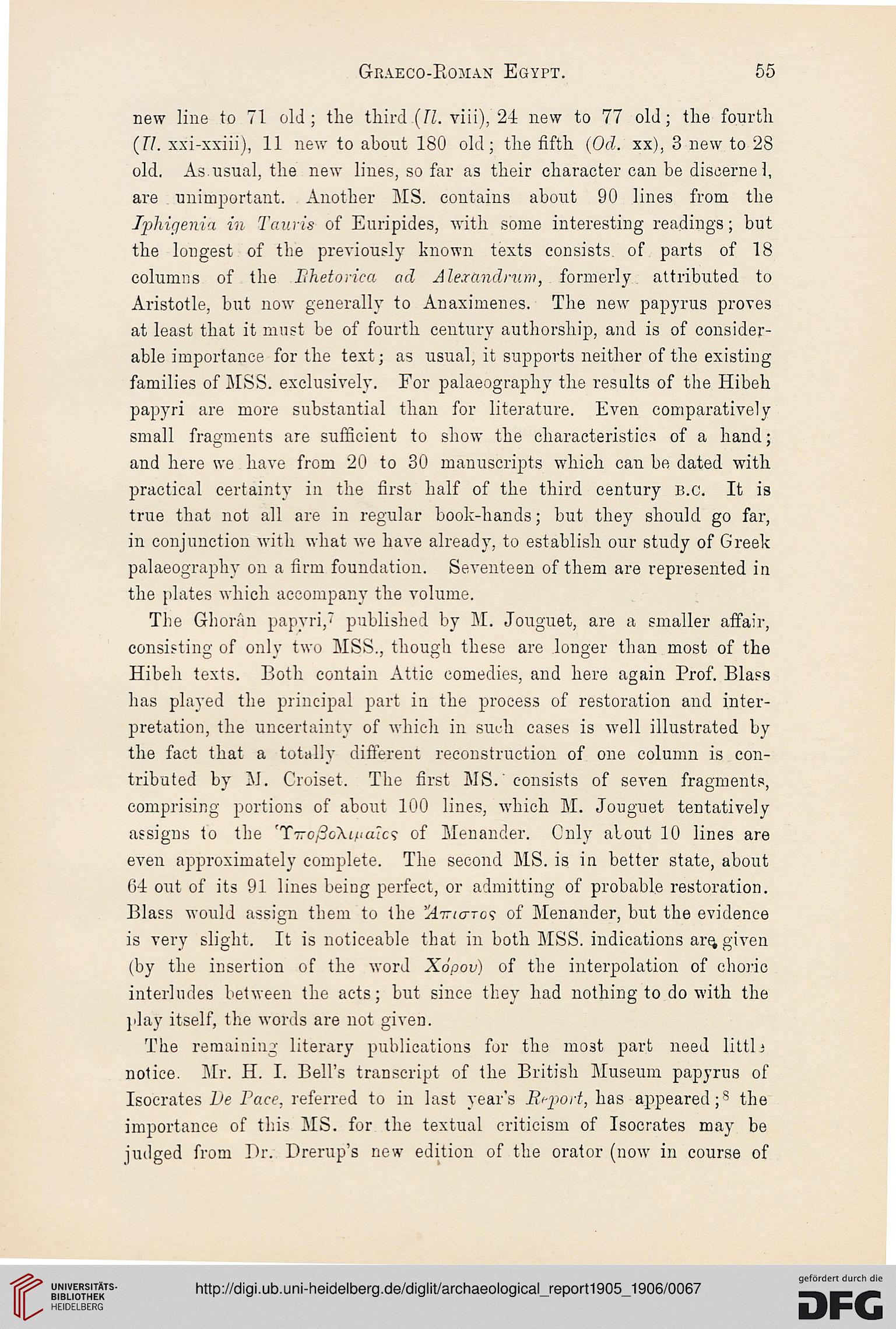Graeco-Boman Egypt.
55
new line to 71 old; the third.(II. viii), 24 new to 77 old; the fourth
(77. xxi-xxiii), 11 new to ahout 180 old; the fifth (Od. xx), 3 new to 28
old. As usual, the new lines, so far as their character can be discernel,
are unimportant. Another MS. contains about 90 lines from the
Iphigenia in Tauris of Euripides, with some interesting readings; but
the longest of the previously known texts consists of parts of 18
columns of the Iiketorica ad Alexandrian, formerly attributed to
Aristotle, but now generally to Anaximenes. The new papyrus proves
at least that it must be of fourth century authorship, and is of consider-
able importance for the text; as usual, it supports neither of the existing
families of MSS. exclusively. For palaeography the results of the Hibeh
papyri are more substantial than for literature. Even comparatively
small fragments are sufficient to show the characteristic* of a hand;
and here we have from 20 to 30 manuscripts which can be dated with
practical certainty in the first half of the third century B.C. It is
true that not all are in regular book-hands; but they should go far,
in conjunction with what we have already, to establish our study of Greek
palaeography on a firm foundation. Seventeen of them are represented in
the plates which accompany the volume.
The Ghoran papyri," published by M. Jouguet, are a smaller affair,
consisting of only two MSS., though these are longer than most of the
Hibeh texts. Both contain Attic comedies, and here again Brof. Blass
has played the principal part in the process of restoration and inter-
pretation, the uncertainty of which in such cases is well illustrated by
the fact that a totally different reconstruction of one column is con-
tributed by M. Croiset. The first MS.'consists of seven fragments,
comprising portions of about 100 lines, which M. Jouguet tentatively
assigns to the 'T^O/ScA^/aFc? of Menander. Only alout 10 lines are
even approximately complete. The second MS. is in better state, about
G4 out of its 91 lines being perfect, or admitting of probable restoration.
Blass would assign them to the 'A-iria-cs of Menander, but the evidence
is very slight. It is noticeable that in both MSS. indications are, given
(by the insertion of the word Xopov) of the interpolation of choric
interludes between the acts; but since they had nothing to do with the
play itself, the words are not given.
The remaining literary publications for the mo3t part need littli
notice. Mr. H. I. Bell's transcript of the British Museum papyrus of
Isocrates l)e Pace, referred to in last year's Report, has appeared;8 the
importance of this MS. for the textual criticism of Isocrates may be
judged from Br. Drerup's new edition of the orator (now in course of
55
new line to 71 old; the third.(II. viii), 24 new to 77 old; the fourth
(77. xxi-xxiii), 11 new to ahout 180 old; the fifth (Od. xx), 3 new to 28
old. As usual, the new lines, so far as their character can be discernel,
are unimportant. Another MS. contains about 90 lines from the
Iphigenia in Tauris of Euripides, with some interesting readings; but
the longest of the previously known texts consists of parts of 18
columns of the Iiketorica ad Alexandrian, formerly attributed to
Aristotle, but now generally to Anaximenes. The new papyrus proves
at least that it must be of fourth century authorship, and is of consider-
able importance for the text; as usual, it supports neither of the existing
families of MSS. exclusively. For palaeography the results of the Hibeh
papyri are more substantial than for literature. Even comparatively
small fragments are sufficient to show the characteristic* of a hand;
and here we have from 20 to 30 manuscripts which can be dated with
practical certainty in the first half of the third century B.C. It is
true that not all are in regular book-hands; but they should go far,
in conjunction with what we have already, to establish our study of Greek
palaeography on a firm foundation. Seventeen of them are represented in
the plates which accompany the volume.
The Ghoran papyri," published by M. Jouguet, are a smaller affair,
consisting of only two MSS., though these are longer than most of the
Hibeh texts. Both contain Attic comedies, and here again Brof. Blass
has played the principal part in the process of restoration and inter-
pretation, the uncertainty of which in such cases is well illustrated by
the fact that a totally different reconstruction of one column is con-
tributed by M. Croiset. The first MS.'consists of seven fragments,
comprising portions of about 100 lines, which M. Jouguet tentatively
assigns to the 'T^O/ScA^/aFc? of Menander. Only alout 10 lines are
even approximately complete. The second MS. is in better state, about
G4 out of its 91 lines being perfect, or admitting of probable restoration.
Blass would assign them to the 'A-iria-cs of Menander, but the evidence
is very slight. It is noticeable that in both MSS. indications are, given
(by the insertion of the word Xopov) of the interpolation of choric
interludes between the acts; but since they had nothing to do with the
play itself, the words are not given.
The remaining literary publications for the mo3t part need littli
notice. Mr. H. I. Bell's transcript of the British Museum papyrus of
Isocrates l)e Pace, referred to in last year's Report, has appeared;8 the
importance of this MS. for the textual criticism of Isocrates may be
judged from Br. Drerup's new edition of the orator (now in course of




